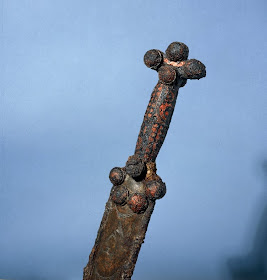 |
| View from the side and below |
The finial is, most likely, a sword pommel. Early sword pommels are extremely rare, most of them having parted with the sword long before the sword was found. The commonest sort of pommels are much later and are the head section of an anthropormorphic sword hilt consisting of head and arms at the end, an undetailed body section which is simply the grip, and the legs, which take the position of quillons. Sword pommels were lost frequently and the makers were always attempting new methods of attaching them to the sword. One of them in my own collection has an indented side -- made to rest against one of the arms, and there is a small hole bored in one side of the top of the head, presumably to accommodate a locking tab that forms part of the arm. The female ferrule had an internal design reminiscent of a Phillips type screw save for the fact that one arm of the cross is set lower to gain greater stability. Yet, that pommel was also lost from its hilt -- a reminder that soldering or welding was unknown at the time and that necessity is not always the mother of invention. The most elaborate anthropomorphic sword pommel of which I am aware is this one.
 |
|
|
Sword pommels are the sort of object that were always getting lost from the sword, as we can see from the elaborate attempts that the craftsmen made to overcome this problem. As this was, evidently, a stray find (also typical for much British metalwork of the time, as is mentioned in most of the texts on the subject), Occam's Razor would suggest that the object is a sword pommel and not, say, the finial from a small box. The evidence of an internal iron tang or pin also supports this hypothesis. The next episode will focus on the place of this object within the evolution of British early Celtic art.
No comments:
Post a Comment